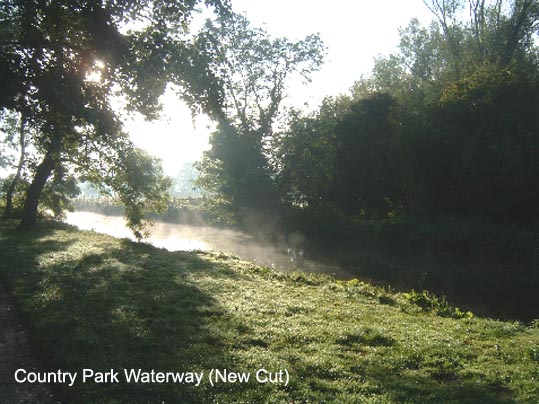

In 1971, following the closure of the Stour Valley railway line between Sudbury and Cambridge four years earlier, the railway-owned land at Clare was purchased jointly by West Suffolk County Council and Clare Rural District Council (as they then were called).
After lengthy negotiations, Mr J.A. DeFonblanque had agreed to donate some adjacent land towards the formation of a projected country park as long as the two councils agreed to purchase the necessary railway land. That proviso being satisfied, the two parcels of land were combined to create the Clare Castle Country Park, which was formally opened in 1972 and jointly administered by the two above-named councils.
Subsequent local government reorganisation in 1974,
meant that West Suffolk County Council and Clare Rural District Council
were abolished, and management of the new site became the responsibility
of the nascent Suffolk County Council (formally, from within the Department
of Planning).
Since the Country Park was the first of its type in the country, there
were no guidelines to work to, and the site was initially run as a nature
reserve. Over the years, the emphasis has subtly evolved to accommodate
recreational as well as conservational activities, and this is what we
witness today.
Suffolk-born John Laws arrived in 1976 as the Park’s second warden, and has presided over most of the significant changes that have occurred over the last thirty-odd years. John, a metallurgist by training, had been working in the research laboratories of Delta Metals in Ipswich when he saw the Clare job advertised. The draw of being able to work with wildlife in a countryside environment appealed to him greatly, and he decided to ‘go for it’. There were no trained ‘environmentalists’ in those days, in fact the word had hardly been invented, and so John stood as much chance as any of the other candidates applying for the job. The rest, as they say, is history.
As John freely admits: “The time seemed just right, and the opportunity to work outdoors with nature was a rarity, and too good to miss”. The first warden, from 1972 to 1976, was Mike Stagg, an ex-policeman and forester, who moved on to become Suffolk Heritage Coast Warden on leaving Clare.
On joining the project, John was given the job of looking after five sites: Clare; Rodbridge; Lavenham walk; Melford walk, and ‘valley walk’ (from Rodbridge to Sudbury). For a while, John looked after these sites on his own, but was later allowed to employ a couple of part-time staff (5-6 hours per week) to look after the four ‘satellite sites’. Their remit was mainly concerned with addressing the question of litter and reporting any other problems.
When a variety of Government job-creation initiatives (Youth Opportunities Scheme, Youth Training Scheme, etc.) were invoked during the late 70s/early 80s, Suffolk County Council became involved in them, and so was able to supply some valuable partly-funded labour (4-5 people at times) for the Country Park. As a result, during the next few years much valuable work was carried out, such as the clearance of dead (infected) elms, tree-planting, and the refurbishment of the visitor centre (which was in danger of closure at one point, because of its dangerous condition). When these Government schemes finished, John was ‘back on his own’ again – but with a much enhanced workload, mainly attributable to the burgeoning Visitor Centre.
To alleviate the situation, the County Council agreed to a new, full-time post of ‘Assistant Ranger’ at Clare, and with a couple of casual workers, plus several volunteer groups (such as the Scouts), the Park, and its satellites were run efficiently for the next decade, or so.

Then, around ten years ago, there was a reorganisation, whereby the satellite sites were awarded their own supervisor. In County Council speak, this was “three-quarters of a full-time post” (although I gather that finding three-quarters of a person proved rather difficult!). In addition, John became a Senior Ranger, a new designation, and the positions of Ranger and Assistant Ranger were maintained.
So the present staff complement is four, plus a part-time cleaner who looks after the toilet facilities and offices. Their estate has increased somewhat, because a picnic site at Glemsford has been added (south of the A1092, off the minor road to Pentlow and Foxearth). The Country Park is now administered by the Countryside Section of Suffolk County Council’s Environment & Transport Division.
Clare Country Park Past and Present
Clare Country Park The Arrival of the Railway
Clare Country Park Managing the Country Park
CLARE COUNTRY PARK
- MODERN TIMES
By Ian Hornsey